Uveal Melanoma Treatment Market Size
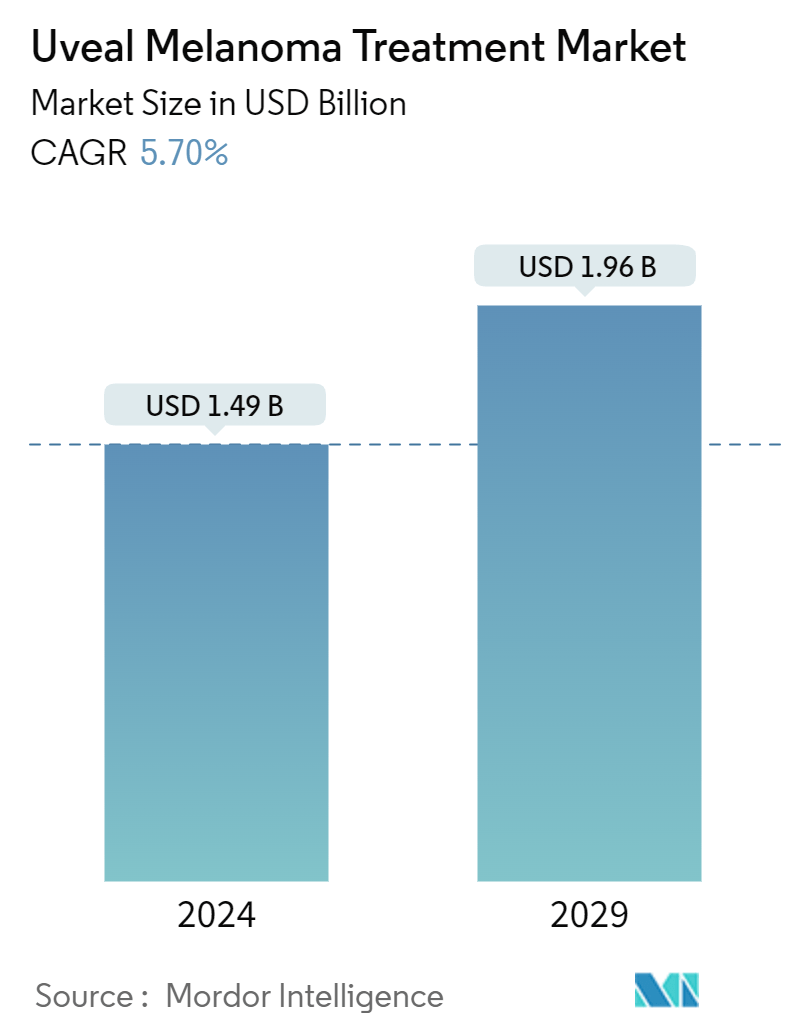
| Study Period | 2019 - 2029 |
| Market Size (2024) | USD 1.49 Billion |
| Market Size (2029) | USD 1.96 Billion |
| CAGR (2024 - 2029) | 5.70 % |
| Fastest Growing Market | Asia Pacific |
| Largest Market | North America |
Major Players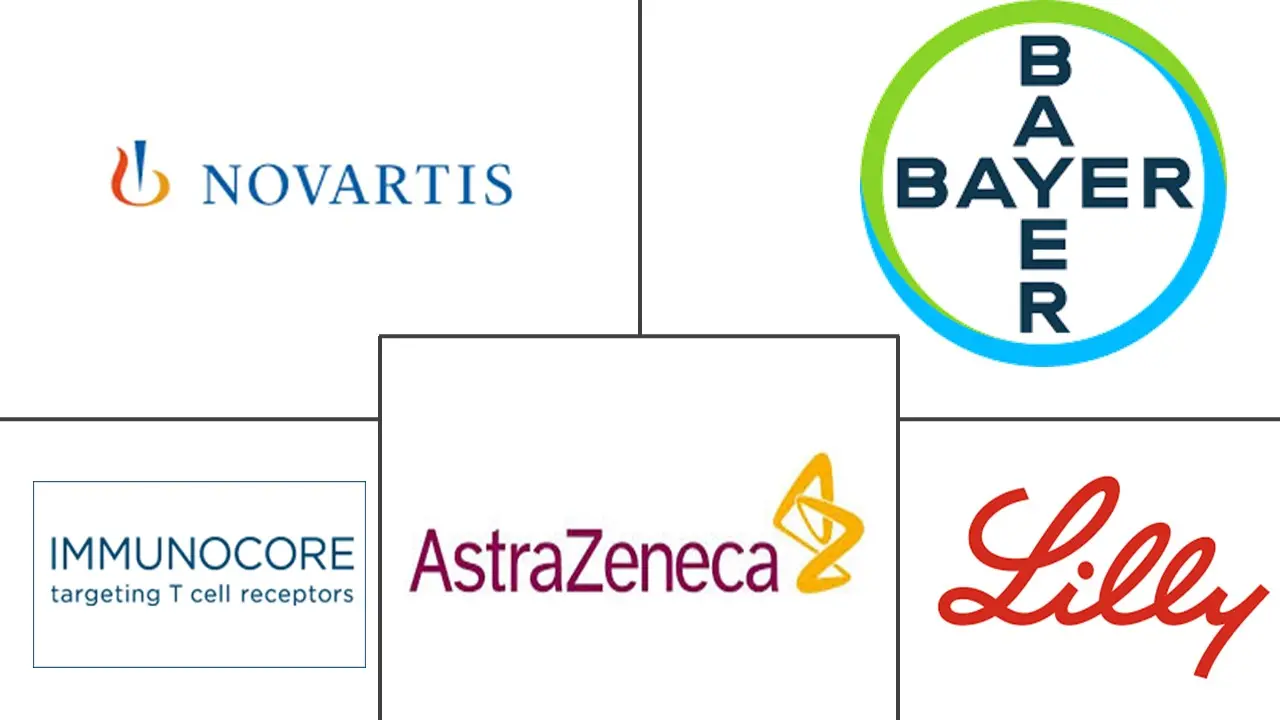
*Disclaimer: Major Players sorted in no particular order |
Uveal Melanoma Treatment Market Analysis
The Uveal Melanoma Treatment Market size is estimated at USD 1.49 billion in 2024, and is expected to reach USD 1.96 billion by 2029, growing at a CAGR of 5.70% during the forecast period (2024-2029).
Uveal melanoma is a rare and aggressive form of eye cancer that originates from the uveal tract, including the iris, ciliary body, and choroid. The rising geriatric population and a surge in eye cancer prevalence are expected to propel the market's growth in the coming years. The Centers for Disease Control and Prevention (CDC) publication on the United States Cancer Statistics in 2022 highlights the critical importance of monitoring cancer incidence rates.
Uveal melanoma, the most common primary intraocular cancer in adults, is estimated to affect 5.1 individuals per million annually in the United States. This data underscores the need for continued vigilance and targeted interventions to address this specific type of cancer. Uveal melanoma is frequently observed in older age groups, with its age-specific incidence rate steadily increasing and peaking around the age of 70, then stabilizing after 75 years. According to the World Health Organization 2022, the number of people aged 60 years and above is expected to reach 1.4 billion by 2030 and 2.1 billion by 2050. Thus, the surge in the geriatric population is expected to drive the growth of the uveal melanoma treatment market in the forthcoming years.
In addition, advancements in research and drug development are fueling the market's growth. A better understanding of the molecular and genetic biology of uveal melanoma has led to the development of targeted therapies. For instance, in April 2024, groundbreaking research from the University of Pittsburgh demonstrated that metastatic uveal melanoma can be effectively treated with adoptive therapy, which involves cultivating the patient's T cells outside the body before reinfusing them. This development is expected to significantly drive the uveal melanoma market by introducing a novel and promising treatment option. The success of adoptive therapy in clinical trials enhances the therapeutic landscape and attracts increased investment and research efforts, potentially leading to further advancements and expanded treatment options for patients with uveal melanoma. Furthermore, in October 2023, the US FDA granted approval to iOnctura to proceed with the clinical trial phase-I investigating Roginolisib (IOA-244) for the treatment of uveal melanoma.
Moreover, the increasing incidence of uveal melanoma, particularly in older populations, underscores the need for innovative and effective treatment options. As the global population ages, the number of individuals diagnosed with uveal melanoma is expected to rise, amplifying the demand for advanced therapies that can offer better outcomes with fewer side effects. Targeted therapies, with their ability to specifically attack cancer cells while sparing normal tissues, align well with the treatment needs of an aging population, who may be more susceptible to the adverse effects of conventional therapies.
However, the high cost of treatment and lack of skilled professionals are restraining the growth of the market during the forecast period.
Uveal Melanoma Treatment Market Trends
The Targeted Therapy Segment is Expected to Witness Significant Growth During the Forecast Period
There are a number of important factors driving the targeted therapy segment in the treatment of uveal melanoma, which reflects changing clinical needs and advances in medical research. Gaining more insight into the genetic and molecular makeup of uveal melanoma is one of the main motivators. A 2022 Journal publication by the National Institutes of Health revealed critical mutations and pathways in the GNAQ, GNA11, BAP1, and SF3B1 genes that support tumor growth and metastasis in uveal melanoma. These genetic insights have catalyzed the development of targeted therapies designed to inhibit specific molecular mechanisms. This advancement represents a significant shift in the uveal melanoma treatment landscape, offering precise and effective options compared to traditional methods. The identification of these pathways enhances the potential for personalized medicine and presents substantial market opportunities for pharmaceutical companies investing in targeted cancer therapies.
Several ongoing clinical trials are evaluating the role of immunotherapy in the management of uveal melanoma. Several ongoing clinical trials are exploring the role of immunotherapy in the management of uveal melanoma, aiming to improve patient outcomes by harnessing the body's immune system to target and destroy cancer cells. For instance, a phase II clinical trial is evaluating the efficacy of pembrolizumab, a PD-1 inhibitor, in patients with metastatic uveal melanoma. Another notable trial is investigating the combination of nivolumab and ipilimumab, both immune checkpoint inhibitors, to determine their effectiveness in controlling tumor growth and prolonging survival. Additionally, a study is assessing the use of adoptive cell therapy involving tumor-infiltrating lymphocytes (TILs), which are extracted from the patient's tumor, expanded in the lab, and reinfused to boost the immune response against cancer cells. These trials represent significant steps forward in developing new, potentially life-saving treatments for uveal melanoma.
According to a 2022 Journal published by the National Institutes of Health, a key focus area is the development of IDH1 inhibitors such as ivosidenib (AG-120). These drugs target metabolic pathways altered by mutations in the IDH1 gene, which result in the production of oncometabolites that drive tumor growth. By inhibiting IDH1, these therapies aim to disrupt this process, potentially slowing or halting disease progression. Current clinical trials are evaluating the effectiveness and safety of IDH1 inhibitors for patients with uveal melanoma harboring these specific mutations.
According to a Journal published by the National Institute of Health in 2022, the advent of bispecific T-cell engagers (BiTEs) also marks a promising development in targeted therapy. These innovative agents are engineered to bind simultaneously to T-cells and cancer cells, thereby directing the immune system to attack the tumor more effectively. One example is IMCgp100 (tebentafusp), which is being tested in clinical trials for uveal melanoma. Initial findings suggest that BiTEs can elicit a positive clinical response with a manageable safety profile, warranting further exploration in larger trials to confirm their potential benefits.
In conclusion, the targeted therapy segment in the uveal melanoma treatment market is poised for substantial growth, driven by advancements in genetic research, the identification of key mutations and pathways, and the development of precise, effective therapies that offer improved outcomes over traditional treatments.
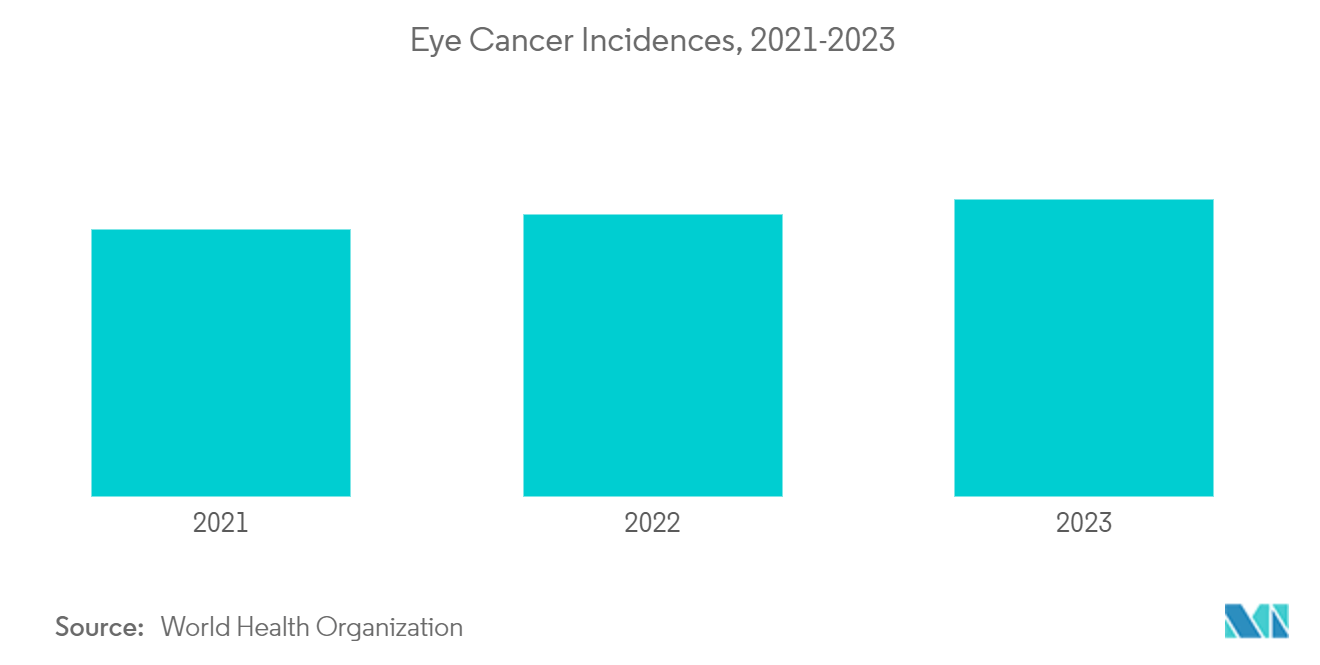
North America is Expected to Dominate the Market
North America is expected to dominate the market due to rising incidence rates of eye cancer, technological advancements in drug discovery, the surge in the geriatric population, the presence of key players, and increasing research and development activities. In North America, the incidence of uveal melanoma varies, with the United States reporting approximately 5.1 cases per million people annually, according to data from the National Cancer Institute (NCI), 2021. This translates to about 1,500 new cases each year. Already, uveal melanoma is more common among individuals with lighter skin and those with certain genetic predispositions. In addition to this, according to Melanoma Canada 2022 stats, approximately 200 people are diagnosed with uveal melanoma every year.
Moreover, the presence of regulatory bodies, such as the FDA, is streamlining the approval process for new therapies, providing expedited pathways for treatments that address unmet medical needs. For example, in August 2023, the FDA approved Hepzato Kit, developed by Delcath Systems Inc., as a liver-targeted therapy for adult patients with uveal melanoma who have unresectable liver metastases affecting less than 50% of the liver and no disease outside the liver or only extrahepatic disease confined to the bone, lymph nodes, subcutaneous tissues, or lung that can be treated with surgery or radiation.
Additionally, several prominent players in the market are focused on expanding their product portfolio, which in turn is projected to create numerous growth opportunities for the market, thereby influencing the market's growth in the region. For instance, in June 2024, IDEAYA Biosciences Inc. announced promising clinical results from the ongoing investigator-sponsored Phase 2 trial of darovasertib as neoadjuvant/adjuvant treatment in uveal melanoma (UM) and a clinical update for a Phase 2 company-sponsored neoadjuvant UM study.
Therefore, owing to the factors mentioned above, the growth of the studied market is anticipated in North America.
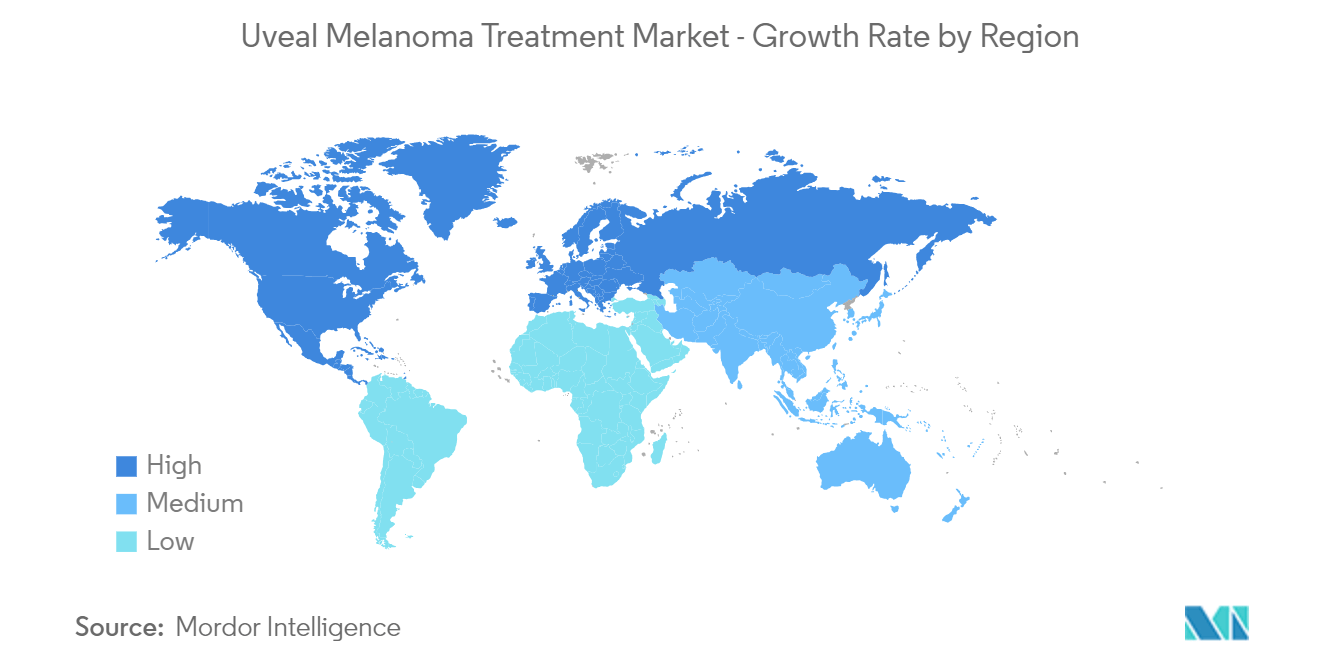
Uveal Melanoma Treatment Industry Overview
The uveal melanoma treatment market is fragmented in nature due to the presence of several companies operating globally and regionally. The competitive landscape includes an analysis of a few international and local companies that hold significant market share and are well known, including Eli Lilly and Company, Novartis AG, Bayer AG, Immunocore Holdings PLC, AstraZeneca, IDEAYA Biosciences Inc., Merck & Co. Inc., DAIICHI SANKYO COMPANY, iOnctura, and Bristol-Myers Squibb.
Uveal Melanoma Treatment Market Leaders
-
Eli Lilly and Company
-
Novartis AG
-
Bayer AG
-
AstraZeneca
-
Bristol-Myers Squibb
*Disclaimer: Major Players sorted in no particular order
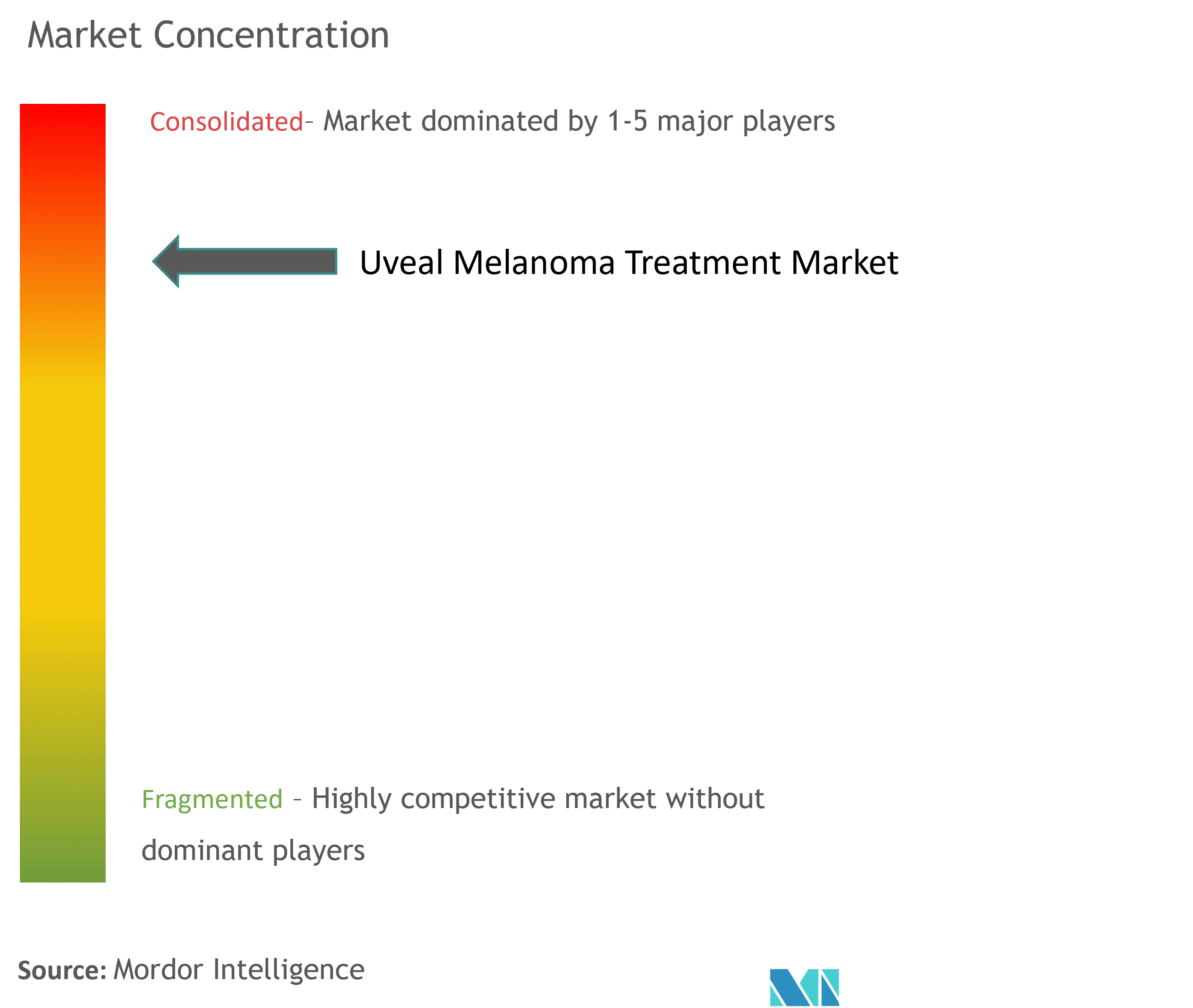
Uveal Melanoma Treatment Market News
• November 2023: The European Organisation for Research and Treatment of Cancer (EORTC) collaborated with Immunocore to initiate a clinical trial ATOM investigating the adjuvant treatment of uveal melanoma with tebentafusp.
• May 2023: IDEAYA Biosciences Inc. announced that it had modified its supply and collaboration agreements for clinical trials with Pfizer Inc. to support the company's ongoing Phase 2 clinical trial in metastatic uveal melanoma (MUM) as well as the evaluation of darovasertib and crizotinib combination therapy in the company's planned Phase 2/3 registrational clinical trial in MUM.
Uveal Melanoma Treatment Market Report - Table of Contents
1. INTRODUCTION
- 1.1 Study Assumptions and Market Definition
- 1.2 Scope of the Study
2. RESEARCH METHODOLOGY
3. EXECUTIVE SUMMARY
4. MARKET DYNAMICS
- 4.1 Market Overview
-
4.2 Market Drivers
- 4.2.1 Rising Incidences of Eye Cancer
- 4.2.2 Continuous R&D Activities and Innovations in Therapies
- 4.2.3 Increasing Awareness and Early Detection
-
4.3 Market Restraints
- 4.3.1 High Cost of Treatment
-
4.4 Porter's Five Forces Analysis
- 4.4.1 Threat of New Entrants
- 4.4.2 Bargaining Power of Buyers/Consumers
- 4.4.3 Bargaining Power of Suppliers
- 4.4.4 Threat of Substitute Products
- 4.4.5 Intensity of Competitive Rivalry
5. MARKET SEGMENTATION (Market Size by Value - USD)
-
5.1 By Therapy Type
- 5.1.1 Surgical Resection Techniques
- 5.1.2 Radiation Therapy
- 5.1.3 Transpupillary Thermotherapy
- 5.1.4 Targeted Therapy
- 5.1.5 Other Therapy Types
-
5.2 By End User
- 5.2.1 Hospitals
- 5.2.2 Opthalmology Centers
- 5.2.3 Other End Users
-
5.3 Geography
- 5.3.1 North America
- 5.3.1.1 United States
- 5.3.1.2 Canada
- 5.3.1.3 Mexico
- 5.3.2 Europe
- 5.3.2.1 Germany
- 5.3.2.2 United Kingdom
- 5.3.2.3 France
- 5.3.2.4 Italy
- 5.3.2.5 Spain
- 5.3.2.6 Rest of Europe
- 5.3.3 Asia-Pacific
- 5.3.3.1 China
- 5.3.3.2 Japan
- 5.3.3.3 India
- 5.3.3.4 Australia
- 5.3.3.5 South Korea
- 5.3.3.6 Rest of Asia-Pacific
- 5.3.4 Middle East and Africa
- 5.3.4.1 GCC
- 5.3.4.2 South Africa
- 5.3.4.3 Rest of Middle East and Africa
- 5.3.5 South America
- 5.3.5.1 Brazil
- 5.3.5.2 Argentina
- 5.3.5.3 Rest of South America
6. COMPETITIVE LANDSCAPE
-
6.1 Company Profiles
- 6.1.1 Eli Lilly and Company
- 6.1.2 Novartis AG
- 6.1.3 Bayer AG
- 6.1.4 Immunocore Holdings PLC
- 6.1.5 AstraZeneca
- 6.1.6 IDEAYA Biosciences Inc.
- 6.1.7 Merck & Co. Inc.
- 6.1.8 DAIICHI SANKYO COMPANY
- 6.1.9 iOnctura
- 6.1.10 Bristol-Myers Squibb
- *List Not Exhaustive
7. MARKET OPPORTUNITIES AND FUTURE TRENDS
** Subject To AvailablityUveal Melanoma Treatment Industry Segmentation
Uveal melanoma is a rare and aggressive form of eye cancer that originates in the uveal tract of the eye, which consists of three parts: the iris, ciliary body, and choroid. This cancer primarily affects adults and is the most common primary intraocular malignancy in this demographic. Despite its rarity, uveal melanoma poses significant clinical challenges due to its potential for metastasis and the critical functions of the affected ocular structures.
The uveal melanoma treatment market is segmented into therapy type, end-user, and geography. By therapy type, the market is segmented into surgical resection techniques, radiation therapy, transpupillary thermotherapy, targeted therapy, and other therapy types. By end-user, the market is segmented into ophthalmic centers, hospitals, and other end users. By geography, the market is segmented into North America, Europe, Asia-Pacific, South America, and Middle East and Africa. The report also offers the market size and forecasts for 17 countries across the region. For each segment, the market sizing and forecasts were made on the basis of value (USD).
Uveal Melanoma Treatment Market Research FAQs
How big is the Uveal Melanoma Treatment Market?
The Uveal Melanoma Treatment Market size is expected to reach USD 1.49 billion in 2024 and grow at a CAGR of 5.70% to reach USD 1.96 billion by 2029.
What is the current Uveal Melanoma Treatment Market size?
In 2024, the Uveal Melanoma Treatment Market size is expected to reach USD 1.49 billion.
Who are the key players in Uveal Melanoma Treatment Market?
Eli Lilly and Company, Novartis AG, Bayer AG, AstraZeneca and Bristol-Myers Squibb are the major companies operating in the Uveal Melanoma Treatment Market.
Which is the fastest growing region in Uveal Melanoma Treatment Market?
Asia Pacific is estimated to grow at the highest CAGR over the forecast period (2024-2029).
Which region has the biggest share in Uveal Melanoma Treatment Market?
In 2024, the North America accounts for the largest market share in Uveal Melanoma Treatment Market.
What years does this Uveal Melanoma Treatment Market cover, and what was the market size in 2023?
In 2023, the Uveal Melanoma Treatment Market size was estimated at USD 1.41 billion. The report covers the Uveal Melanoma Treatment Market historical market size for years: 2019, 2020, 2021, 2022 and 2023. The report also forecasts the Uveal Melanoma Treatment Market size for years: 2024, 2025, 2026, 2027, 2028 and 2029.
Uveal Melanoma Treatment Industry Report
Statistics for the 2024 Uveal Melanoma Treatment market share, size and revenue growth rate, created by Mordor Intelligence™ Industry Reports. Uveal Melanoma Treatment analysis includes a market forecast outlook for 2024 to 2029 and historical overview. Get a sample of this industry analysis as a free report PDF download.



